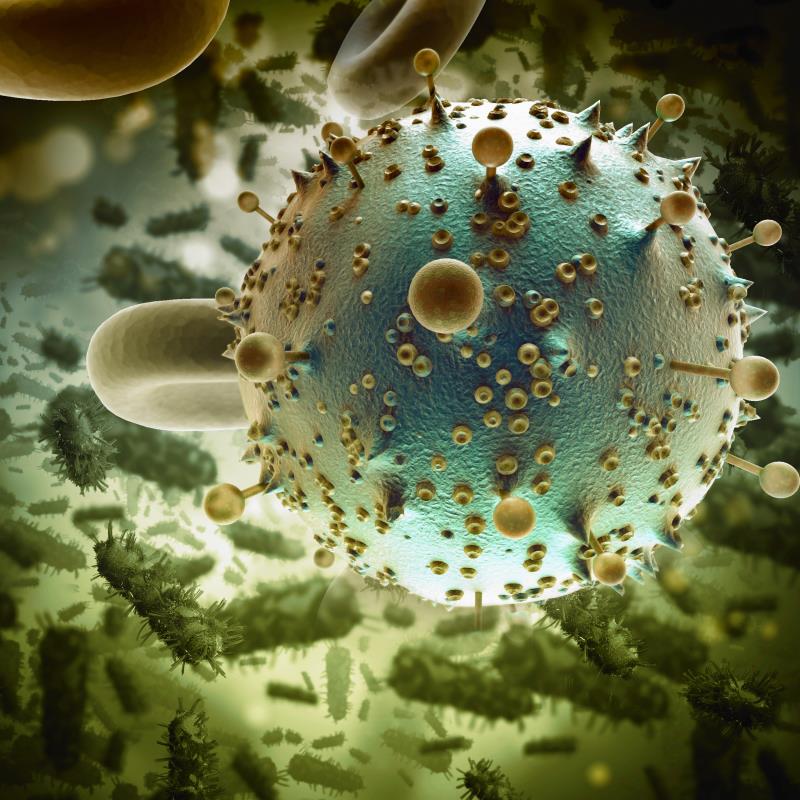A long-acting (LA) injectable therapeutic regimen comprising the integrase strand-transfer inhibitor cabotegravir and the nonnucleoside reverse-transcriptase inhibitor rilpivirine shows therapeutic potential over an oral antiretroviral therapy (ART) regimen in adults with HIV-1, according to the week 96 results of the phase III FLAIR* trial.
Despite the success of daily oral ART, challenges remain given issues such as pill burden, drug/food interactions, adherence, and stigma, noted Professor Chloe Orkin from the Queen Mary University in London, UK, who presented the findings. These inconveniences heighten the risks of nonadherence and treatment failure, hence the drive to develop LA alternatives for HIV-1 infection, she added.
A total of 629 ART-naïve adults received induction therapy with daily oral ART consisting of a single-tablet regimen of abacavir/dolutegravir/lamivudine (ABC/DTG/3TC) for 20 weeks. After 16 weeks, 566 patients (median age 34 years, 78 percent male, HIV-1 RNA <50 c/mL) entered the maintenance phase and were randomized 1:1 to either switch to monthly intramuscular injections of LA cabotegravir 400 mg and rilpivirine 600 mg or continue oral ART regimen. Those who switched received an oral lead-in of cabotegravir 30 mg and rilpivirine 25 mg once daily for 4 weeks prior to switch. [CROI 2020, abstract 482]
At week 96, 3.2 percent of participants in each arm had HIV-1 RNA ≥50 c/mL, underlining the noninferiority of the injectable regimen to oral ART established at week 48. Noninferiority was also achieved for the viral load of HIV-1 RNA <50 c/mL (86.6 percent vs 89.4 percent for the injectable vs the oral ART regimen, respectively).
Even though the study was not powered to look at the 6-percent noninferiority margin, noninferiority was met for both outcomes, Orkin pointed out.
Despite the similar incidence of total confirmed virologic failure** (CVF) through week 96 (4 in each arm), no CVFs were reported from week 48 through 96 in the injectable vs the oral ART arm (0 vs 1).
“Probably the [key] take away from this study is that there were no instances of resistance in the injectable arm beyond week 48. This is a very important finding,” highlighted Orkin.
Adverse events (AEs) leading to treatment withdrawal were infrequent in both treatment arms at week 96 (4 percent vs 1 percent for the injectable vs the oral ART arm, respectively). Injection site reactions were the most common treatment-related AEs. Nonetheless, most were grade 1/2 in severity (99 percent) and resolved in ≤7 days (median duration 3 days).
After adjusting for age, sex, race, baseline HIV-1 RNA, and HIV treatment satisfaction questionnaire (HIVTSQ) total score at day 1, treatment satisfaction was significantly greater with the injectable vs the oral regimen at week 96 (adjusted mean difference from baseline HIVTSQ total score, 2.3, 95 percent confidence interval, 1.1–3.5; p<0.001).
The baseline HIVTSQ total score was 59 which, according to Orkin, is “incredibly high” compared against the maximum HIVTSQ total score of 66. “It is very hard to show improvement from ‘fantastic’ – patients were already fantastically satisfied [at baseline. Yet,] they were still able to demonstrate statistical significance in favour of the injection [at week 96. Therefore,] this strongly confirms the week 48 [findings] in terms of patient satisfaction,” she added.
Taken together, the findings support the noninferiority of the LA injectable regimen to oral ART. Cabotegravir-rilpivirine also effectively maintained virologic suppression, was well-tolerated, and was consistent with the week 48 results, thus confirming its durability. “These results build on the positive data collected at week 48 and support the therapeutic potential of [a] monthly LA [cabotegravir-rilpivirine regimen],” said Orkin.
*FLAIR: First Long-Acting Injectable Regimen
**two consecutive HIV-1 RNA ≥200 c/mL
